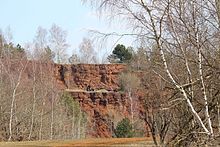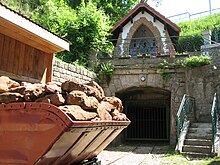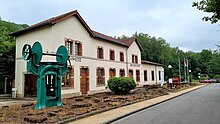
Mining is the extraction of valuable geological materials and minerals from the surface of the Earth. Mining is required to obtain most materials that cannot be grown through agricultural processes, or feasibly created artificially in a laboratory or factory. Ores recovered by mining include metals, coal, oil shale, gemstones, limestone, chalk, dimension stone, rock salt, potash, gravel, and clay. The ore must be a rock or mineral that contains valuable constituent, can be extracted or mined and sold for profit. Mining in a wider sense includes extraction of any non-renewable resource such as petroleum, natural gas, or even water.
The Aciéries Réunies de Burbach-Eich-Dudelange, better known by its acronym ARBED, was a major Luxembourg-based steel- and iron-producing company. Created in 1911 after the merger of three steel-producing companies, ARBED had a significant role in the economy of the Grand Duchy until it merged in 2002 with two other European steel companies to create Arcelor.
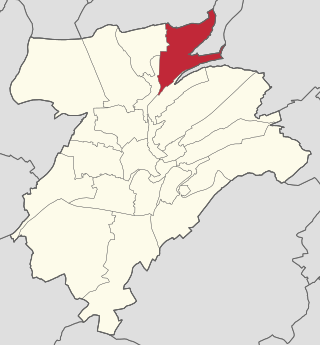
Dommeldange is a quarter in north-eastern Luxembourg City, in southern Luxembourg.
La Cornette is a hamlet of Wallonia in the municipality of Bouillon, district of Bellevaux, located in the province of Luxembourg, Belgium. It is located on the heights of the Semois river in the southern Ardennes, 9 kilometres from downtown Bouillon.
The mineral industry of Russia is one of the world's leading mineral industries and accounts for a large percentage of the Commonwealth of Independent States' production of a range of mineral products, including metals, industrial minerals, and mineral fuels. In 2005, Russia ranked among the leading world producers or was a significant producer of a vast range of mineral commodities, including aluminum, arsenic, cement, copper, magnesium compounds and metals, nitrogen, palladium, silicon, nickel and vanadium.
Mauritania's mineral sector was dominated by iron ore mining and beneficiation. Other mineral commodities produced in the country included cement, copper, gold, gypsum, petroleum, salt, and steel. The 'Ministère des Mines et de l’Industrie' was the Government agency responsible for enacting the Mining Code and for the coordination of all activities in the mining sector. The 'Direction des Mines et de la Géologie' was the entity responsible for promoting the mineral sector and for providing geologic and mining information to potential investors; the 'Direction des Hydrocarbures' was in charge of the development of the petroleum sector; and the 'Office Mauritanien des Recherches Géologiques' was the Government entity responsible for evaluating areas of mineral potential for exploration. The 'Société Nationale Industrielle et Minière (SNIM)' was responsible for iron ore production and benefciation.

The history of rail transport in Luxembourg began in 1846 and continues to the present day.

Oil and gas dominate the extraction industries of the Republic of the Congo, also referred to as Congo-Brazzaville. The petroleum industry accounted for 89% of the country’s exports in 2010. Among African crude oil producers in 2010, The Congo ranked seventh. Nearly all of the country's hydrocarbons were produced off-shore. The minerals sector is administered by the Department of Mines and Geology. Presently no major mining activities are underway, although there are some small-scale domestic operations. However, the country does have numerous large-scale undeveloped resources. The country has recently attracted a strong influx of international companies seeking to tap into the vast mineral wealth.

The Servais Ministry was in office in Luxembourg from 3 December 1867 to 26 December 1874. It was reshuffled four times.

During the German occupation of Luxembourg in World War II, some Luxembourgers collaborated with the country's Nazi occupiers. The term Gielemännchen was adopted by many Luxembourgers, initially to refer to German Nazis in general and later extended to Luxembourg collaborators, deriving from the yellow uniforms of the Nazi Party.

In the industrial sector, the Luxembourg steel industry continues to occupy the first place in the country, even after the industrial reforms which have taken place since the 1960s.
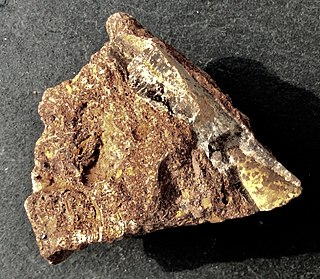
Minette is a type of mineral deposit, consisting of iron ore of sedimentary origin, found in the south of Luxembourg and in Lorraine. Minette ore was deposited in the Early Jurassic and Middle Jurassic.

The mining industry of Liberia has witnessed a revival after the civil war which ended in 2003. Gold, diamonds, and iron ore form the core minerals of the mining sector with a new Mineral Development Policy and Mining Code being put in place to attract foreign investments. In 2013, the mineral sector accounted for 11% of GDP in the country and the World Bank projected a further increase in the sector by 2017.

The mining industry of Senegal is mainly centred on the production of phosphates and industrial limestone. Senegal is one of the leading producers of phosphates in the world, accounting for about 6% of exports in 2006, and deposits are of a particularly high quality. In the coastal region of the country, titanium-bearing minerals have been found and the reserve is estimated at 10 million tons. The mineral sector's exports accounts for 20% of total exports of the country and constitutes 20% of the GDP.

The mining industry of Morocco is important to the national economy. Morocco is the world's largest producer of phosphate, and contains about 75% of the world's estimated reserves. Mining contributed up to 35% of exports and 5% of GDP in 2011. Foreign investors have found the investment climate, the infrastructure, fiscal situation, and political stability very favorable to continue business in the country in this sector.

The Société Mokta El Hadid was an iron ore mining company in Algeria, and later in other West African countries. From around 1865 until 1927 it was the largest mining company in Algeria, delivering ore of exceptional quality for processing in France. In 1878 the original Mokta El Hadid mine near Bône was said to be capable of supporting 25% of Europe's steel production. Before this mine was exhausted the company opened additional mines in Algeria. Later it extended its operations to countries such as Tunisia, Morocco, Niger, Côte-d'Ivoire and Madagascar, and mined manganese, chromium and uranium. In October 1970 the Société le Nickel, soon to become the Imétal holding company, took over the Mokta company. The company was later renamed Compagnie française de Mokta (CFM), specializing in uranium mining.

The mining industry in Sweden has a history dating back 6,000 years.
The metallurgical production of the Republic of Azerbaijan is considered high due to the large deposits of alunite, polymetallic ores, deposits of iron ore, etc. The metallurgy industry of Azerbaijan encompasses both ferrous and non-ferrous branches.
The International Steel Agreement was instituted in 1926 in Europe and was the first international steel cartel. Its purpose was to sustain prices, and to equitably divide up quotas amongst member states and companies, which represented around two-thirds of the world's steel exports, as well as to secure the member states' supplies of iron ore and coke, which were indispensable to their steel industries. It faced difficulties due to Nazi Germany's desire to re-arm and increased British and American exports after the Wall Street Crash of 1929.

Mining in France is based solely on the nature of the material, whether extracted from the surface or underground. These include fuels, metals and a few other minerals.
